Home gardeners get upset when they see that a dry, sunken decay has developed at the blossom end of the Tomato in their garden. This can happen especially so on Tomatoes before the season that has been carefully reared or after a dry period in the summer. This is a disorder called blossom end rot. A calcium imbalance within the plant causes this physical disorder. It can occur in Pepper, Squash, Cucumber, Melon fruits, and Tomatoes.

Blossom end rot in Tomatoes is a common problem for gardeners. The reason for this lies in a plant’s inability to absorb enough calcium to reach fruit. Some common fungal diseases, like early blight, late blight, and Fusarium wilt, causes wilting and rotting of Tomatoes. Tomatoes can also rot due to pests, diseases, and cultural conditions. A common environmental problem faced by home gardeners is blossom end rot.
Why are my Tomatoes rotting on the bottom and top
Why are Tomatoes rotting on the vine before they ripen?
One of the frustrating things that happen to Tomato growers is when it’s too close to harvesting, and suddenly Tomatoes start rotting from the bottom.
Blossom end rot
Insufficient calcium in Tomato tissue causes blossom end rot. Calcium is transported through roots to the plant; however, it settles in a part of the plant. This means that rot can occur even when there is an abundant supply of calcium in the soil, stems, or leaves. Developing Tomatoes must have a constant supply of calcium to prevent these spots from developing. Tomato plants require calcium in all actively growing parts, from roots to fruits. Calcium is transported from one place to another through the water. When the water supply is low, such as during a drought, calcium can’t get from roots to fruit growth, so blossom end rot occurs.
Symptoms of blossom end rot
Blossom end rot causes healthy Tomato fruits to develop brown, leathery spots at the bottom or blossom end. Blossom end rot does not affect the rest of the fruit, and the spot can be cut out. Blossom end rot is caused by several factors, including magnesium or calcium deficiency, irregular watering methods, and over-fertilization, which can interfere with plants’ ability to absorb calcium from the soil. Mostly early fruits suffer from blossom end rot, and later harvest cannot be affected.
Causes of blossom end rot in Tomatoes
Too much moisture in the soil
Inconsistent soil moisture also affects Tomato growth. Since calcium is only transported to the plant with a sufficient moisture supply, fruit growth continues when drought occurs but will be affected by calcium deficiency.
In most cases, Tomato rot is caused by too much moisture in the soil around your Tomato plants. It can come from more water, a year of heavy rain, or the location of your vines. If you plant Tomatoes in an area where they don’t get enough sunlight, the soil will remain moist, which can cause the fruit to rot on the vines. Water-filled soil also interferes with the root’s ability to take nutrients.
In case you missed it: Guide to Growing Tomatoes in Florida: In Winter, Summer, in Backyard and Containers
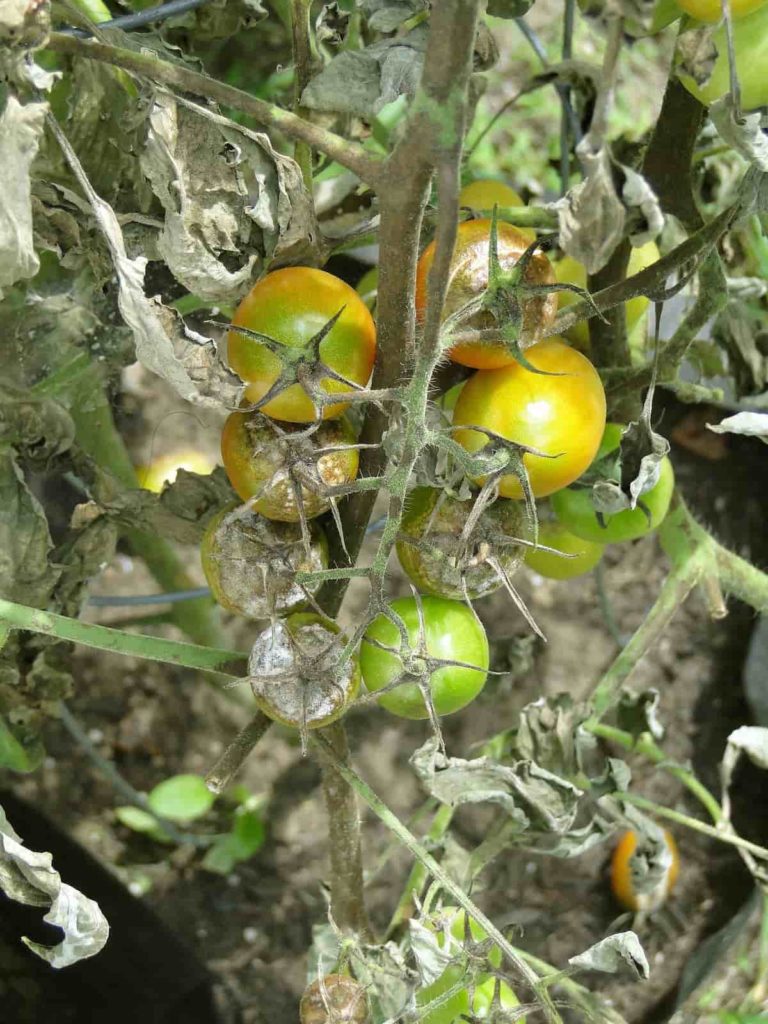
Rapid growth
If you use a forced growth technique to grow Tomatoes faster, you can cause your Tomatoes to rot on vines. This is because rapid growth will rapidly deplete the soil’s calcium supply. Once the soil calcium has gone, Tomato plants cannot produce good fruit. This produces spoiled, rotten Tomatoes on your plants.
The rapid early growth of plants can cause rot because Tomatoes need calcium when actively growing, and plants may not be able to take enough calcium through their roots fast enough. While waiting for these first ripe Tomatoes from the home garden is hard, it’s important not to force the plants to grow too fast to avoid this rot.
Poor soil quality
Improper soil quality is a common cause of Tomato rot. Tomato plants are slightly picky about the balance of nutrients in their soil. Adding the wrong fertilizer only makes blossom-end rot worse. High amounts of nitrogen fertilizer make Tomato plants unable to absorb calcium from the soil. As a result, due to calcium deficiency, Tomatoes rot as soon as they grow. Garden soil may also have low levels of calcium.
Aggressive weeding
Sometimes, Tomato fruits and plants rot if you’re too aggressive with your weeds in the garden. This is because the Tomato has a delicate root system. Pulling weeds into the Tomato root zone can significantly damage these roots. They may struggle to gather soil nutrients when you weaken the roots of your Tomato plant. This produces Tomato fruits that are affected by blossom end rot.
Lack of support
Vining Tomatoes do not have a strong stem to support the entire plant. The Cherry Tomatoes often get the heaviest, even without fruit on them. They can fall, break the stem, and fruits rot if they are not supported. When this happens, the plant may give up Tomato production because the top of the plant may be cut off from the bottom. And remember, the top part of the plant is where Tomatoes are grown.
Pests
Early Blight
Early blight on Tomatoes is characterized by black and brown spots on stems, leaves, and fruits. These spots often form concentric circles and can promote the surrounding yellow area. Spots first appear on lower or older leaves. The disease spreads from the bottom of the plant to the top.
In case you missed it: Best Tomato Varieties in India: Hybrid, Rainy Season, and High Yield
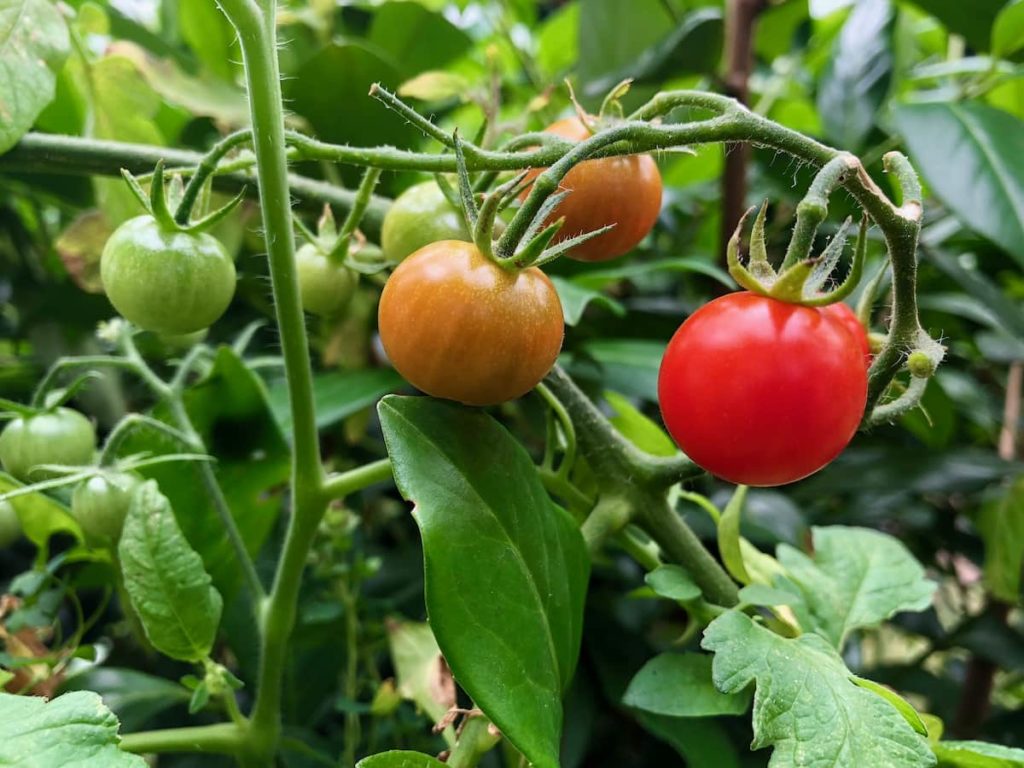
Late blight
Late blight on Tomatoes causes irregular, grayish-green, purple, or dark brown spots on the stems and leaves. The spots are large and spread rapidly, and involve emerging fruit.
Fusarium wilt
Fusarium wilt affects all parts of the Tomato plant and is caused by the soil-dwelling fungus. The disease starts with the yellow leaves, usually only on one side of the plant. Even if sufficient soil moisture is available, wilting can spread throughout the plant. The disease prevents the transportation of water and nutrients from the roots to the rest of the plants.
Curing blossom end rot on Tomatoes
Remove all infected Tomatoes
Once blossom end rot affects the Tomato, it won’t go away. Still, you can save the plant and any remaining Tomatoes it produces. Put all rotten Tomatoes in your compost and reduce your losses.
Water with powdered milk
Although eggshells are great, their calcium will not be picked up by the plant until they start decomposing. It’s great for a few months from now, but it doesn’t help your immediate problem. Instead, mix powdered milk in your water can for a quick hit of calcium that doesn’t resort to using lime. You should use lime if you have a soil pH problem.
Keep Tomato plants well-watered
Tomatoes require about an inch of water a week from rain or irrigation. Supplement the rain when needed by watering Tomatoes with a soaker hose or water can. This is important when growing Tomatoes in containers. Maintain a consistent supply of soil moisture. To discourage leaf diseases, avoid getting the leaves wet as you water. Rain will wet your plants, which helps spread diseases. The more you can keep the leaves dry, the better.
Add mulch around Tomato plants
You should spread a 2-inch-thick layer of organic mulch around the base of your plants. Mulching Tomatoes help retain moisture in the soil. Use organic mulches such as straws free of weed seeds, grass clippings, peat moss, or wood chips. You should remove the infected Tomato when you first noticed. This rot does not spread from plant to plant or fruit to fruit, so even if it occurs on your early Tomato, it may not affect later Tomatoes on the same plant. Fungicides and pesticides are useless as measures to control the disorder.
Don’t over-fertilize
Excess fertilizer can cause plants to grow faster, where they can get calcium, which they need for healthy growth. You should add a 2-inch-thick layer of well-decomposed compost to the soil before planting in the spring. Compost will gradually release nutrients and, at the same time, improve the structure of the soil. Just fertilize if a soil test is recommended, and follow the label instructions exactly.
In case you missed it: Soil Preparation for Tomato Plants: Best Soil Mix, pH, Compost, and the Recipe
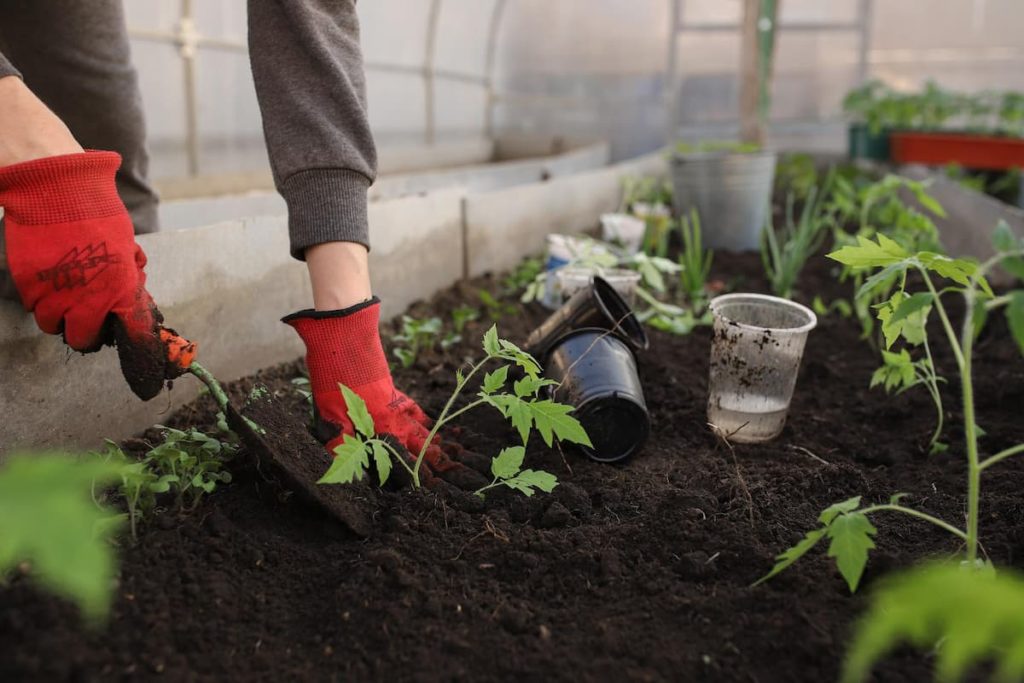
Care for the roots
The roots are necessary to absorb calcium which prevents blossom end rot. Avoid disturbing the Tomato plant’s root zone so it can absorb as much calcium as possible. Avoid hoeing and digging into a plant’s root zone, and keep the weeds at bay with a layer of mulch. Avoid deep cultivation around plants as much as possible after the fruit is set, especially in dry weather. Scarping the soil with a spade is usually enough to control weeds in the home garden.
Add calcium to your soil
- You can work in crushed eggshells at the time of planting. If you don’t have eggshells, try some cheap calcium antacid tablets.
- Low levels of calcium can cause blossom end rot. Dissolve four tablespoons of calcium nitrate in one gallon of water. Place the solution in a spray bottle. Spray Tomato plants with calcium nitrate when they start producing new flowers and apply the solution three times a week during fruit formation.
- Suppose you already have signs of blossom-end rot. In that case, you can make solutions from calcium carbonate antacid tablets, milk, and water and irrigate your plants daily to help prevent blossom-end rot from destroying your crops.
- Natural calcium sources include crushed eggshells, shell meal, and ground shells of marine animals. Make homemade calcium for plants by mixing shell meals or crushed eggshells directly into the soil before planting your Tomatoes. After planting, you can also add eggshells or shell meals to the soil around your Tomato plants to help maintain stable calcium levels during the growing season. Another source of calcium for Tomatoes is the Bone meal, and it also provides phosphorus.
- You may want to use gypsum for Tomatoes if your plants are still not getting enough calcium. This is because plants absorb gypsum, but it does not affect soil acidity. You should spread the gypsum near the Tomato plants and then water the area thoroughly to promote absorption into the soil. Spread the lime spray on the soil’s surface, work slowly, cover with mulch, and water well.
- A really easy way to treat this is to mix a cup of hydrated lime (powder) in a gallon of water and add it well to the water. You’ll only do this once, and any fruit that starts to grow after just a few days will be fine. Don’t overdo it; adding too much lime will burn your plants.
In case you missed it: How to Grow Tomatoes in Michigan: Planting to Harvesting Guide
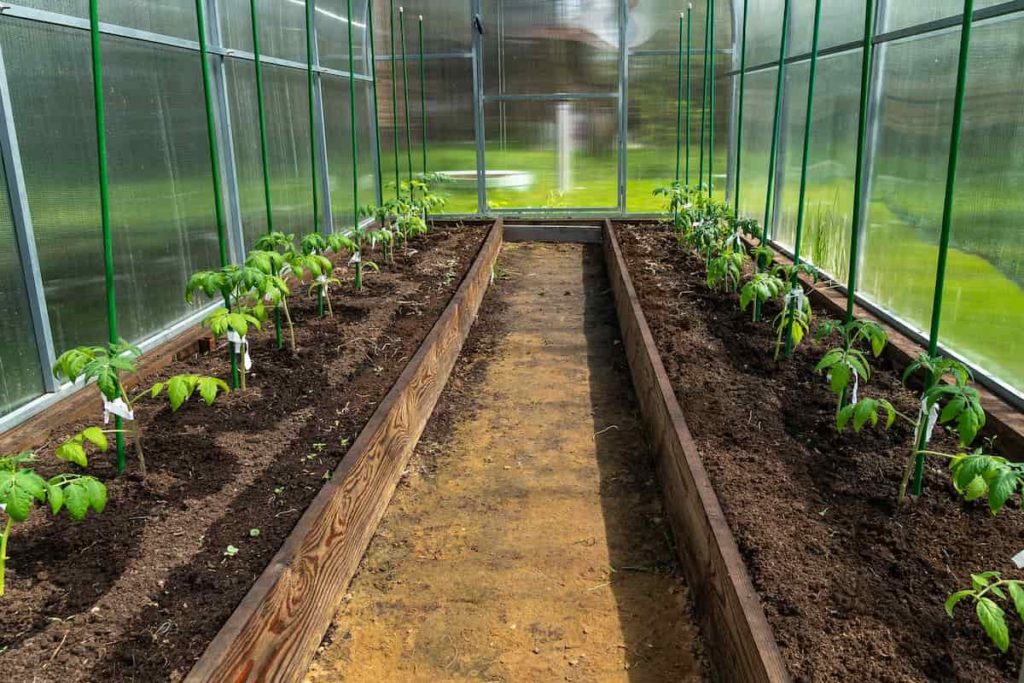
Epsom Salt for Tomato Blossom End Rot
- Epsom salt contains about 10% magnesium and 13% sulfur. Magnesium is essential for seed germination, chlorophyll production, and healthy cell wall development.
- Blossom end rot is a condition that affects Tomato fruits. When the plant can’t take in enough calcium, it becomes deficient, resulting in the normal rot of parts of the fruit that bothers Tomato gardeners. Gardeners will try anything to solve this problem, including Epsom salt.
- Epsom salt provides magnesium sulfate, not calcium. Instead, focus on ensuring your Tomato plant has enough water but doesn’t sit in water-logged soil. To make matters worse, applying Epsom salt to plants affected by the blossom end rot can make the problem more severe. If the plant takes in excess magnesium, it competes with calcium, resulting in less calcium absorption. When trying to fix a problem with your Tomatoes, this is the last thing you want; rather, avoid it altogether.
- If you want to try using Epsom salt to prevent blossom end rot, combine one tablespoon of Epsom salt with 1 gallon of water. Apply this solution as a leaf spray immediately after planting, when the plant first produces flowers and when young Tomatoes appear. You should water Tomato plants repeatedly so that the soil remains evenly moist, never soggy or completely dry.
When to spray Epsom salt on Tomatoes
- The only time you should add Epsom salt to the soil is for intense crop production in soils with magnesium deficiency. It is better to check the soil before adding any amendments to your soil. If calcium deficiency causes blossom end rot, adding Epsom salt can add to the problem because excess magnesium in the soil can interfere with plants’ ability to absorb calcium. The best way is to maintain uniform soil moisture by constantly watering and mulching the plants to avoid blossom end rot.
Blossom end rot on Tomatoes in containers
If you are growing Tomatoes in containers, they are more prone to blossom end rot than those grown in the ground because they dry more quickly. Calcium is supplied for fruit growth through water in the soil. If the soil dries out, plants won’t absorb enough calcium. Water Tomato plants at least daily. You may have to water them more than once in hot weather. Repeatedly try to water so much that the potting soil is as wet as a wrung-out sponge. Smaller containers dry up more quickly than larger containers, increasing the chances of problems.
How to fix blossom end rot in containers
- Dark-colored containers retain heat, which can also cause them to dry out. Place the Tomatoes in the largest containers you can find. The pots should contain at least 5 gallons of soil. The best option is light-colored plastic pots because they reflect heat and are so light that you can move them to a shady location during the extreme afternoon heat.
- Drought is a possible cause of blossom end rot in container plants, although magnesium deficiency may be a secondary cause. Epsom salts provide magnesium and can reduce the risk of blossom end rot. Don’t overdo it, though. Too much fertilizer can cause other problems. Dilute one tablespoon of Epsom salts in a gallon of water and sprinkle the mixture on their leaves after transplanting Tomato plants, as well as when the plants start producing flowers and fruits.
Blossom end rot on Tomatoes in Greenhouse
Tomatoes are delicious and will thrive in the greenhouse. They require a little more care than some of the other growing herbs. You’ll need to take more steps to ensure your Tomatoes get bigger and stronger. Especially those grown in greenhouses, blossom end rot is a common problem for Tomatoes and Peppers. It is caused by irregular watering and excessive drying in the roots. This is often a common problem of plants growing in bags that are not adequately watered.
In case you missed it: How to Grow Tomatoes from Seeds: Starting from Scratch, A Beginners Guide to Indoors, Outdoors, and in Pots
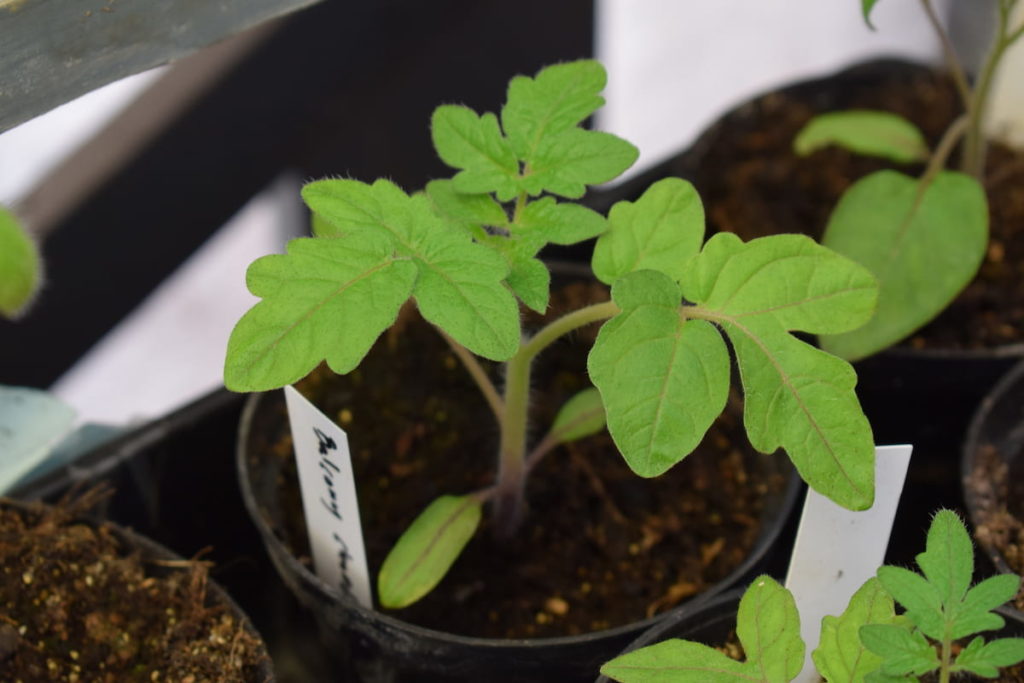
How to fix blossom end rot in greenhouse
- Open the doors on warm days, use proper shading, and try not to go over the plant, as this can reduce airflow. Even when it’s grey and dull, you’ll usually have to leave the doors open for ventilation at this time of year.
- When you water your Tomato plants, try to make sure you pour water near the soil and roots, where water is needed, instead of wetting the leaves.
- The water usually splashes a little, and it is difficult to avoid wetting the plants completely. To minimize the risk of leaves staying wet overnight, you should water in the morning, if possible, to allow things to dry up before temperatures drop at night.
- You can reduce the risk by increasing ventilation around your Tomato plants. You should aim to remove the leaves to the lowest fruit truss.
Conclusion
Tomatoes are garden vegetables, and for a good reason, most everyone loves them. But if Tomatoes are still hanging on the vines, so the ends start rotting, it’s no fun to grow them. Growing a Tomato plant is so heart-breaking that it’s ready to pick before the fruit rots on the vine. Tomatoes can take a few extra steps to get a rich harvest, but they’re worth it. So, get your calcium and give your plants a weekly spray. And now you will control blossom end rot.
- Flower Garden Designs and Layouts for Beginners
- Planting and Spacing Techniques in Papaya: A Beginner’s Guide
- Growing Gold: Essential Techniques for Planting Pineapples
- How to Make Kalanchoe Plant Bushy: Home Remedies and Solutions
- 11 Reasons Why Your Gardenia is Not Blooming: Home Remedies and Solutions
- Eco Elegance: The Guide to Designing a Drought-Tolerant Landscape
- Gardening on a Slope: Strategies for Hillside Landscaping
- Nourish and Flourish: Top Organic Mulches for Thriving House Plants
- Everything You Want to Know about Indian Mogra Flower: Discover Uses and Growing
- Green Thumb Success: Expert Tips for Cultivating Greenhouse Pumpkins All Year Round
- Maximize Growth & Flavor: The Ultimate Guide to Companion Planting in Herb Gardens
- How to Control Rhododendron Problems Naturally: Home Remedies and Organic Ways to Fix Them
- Natural Magic: The Remarkable Benefits of Cinnamon for Plants
- Best Steps to Revive Dying Tulip with Natural and Organic Treatment
- 10 Reasons Why Your Angel Trumpet is Not Blooming: Remedies and Treatment
- How to Fix Periwinkle Leaf and Flower-Related Problems: Natural Remedies and Solutions
- How to Fix Zinnias Leaf and Flower Problems: Discover Natural and Home Remedies
- Organic Steps to Induce Lemon Tree Flowers: A Comprehensive Guide
- Bloom Booster: Crafting the Perfect Homemade Bougainvillea Fertilizer
- Optimizing Growth: A Guide to Applying NPK Fertilizer for Potted Plants
- 10 Best Homemade Fertilizers for Rubber Plant: DIY Recipes and Application Method
- How to Boost Female Pumpkin Flowers: Effective Steps for More Flowers and High Yields
- Transform Your Indoor Garden: Top Benefits of Pink Salt for Houseplants
- 10 Best Homemade Fertilizers for Peacock Plants (Calathea): Easy DIY Guide
- Unlock Blooms: 9 Reasons Why Your Potted Chrysanthemum is Not Blooming
- 8 Reasons Why Your Potted Hibiscus is Not Blooming: Fix it with Simple Solutions
- Unlock Blooms: 9 Key Reasons Your Potted Frangipani Won’t Flower
- 10 Reasons Why Is My Ice Plant Not Blooming: Remedies and Treatment
- 10 Reasons Why My Potted Hydrangea Not Blooming: Treatment and Remedies
- 10 Reasons Why is My Wisteria Not Blooming: Remedies and Treatment
- 10 Reasons Why is My Goldfish Plant Not Blooming: Remedies and Treatment
- Maximize Your Space: Ultimate Guide to Balcony Gardening with Grow Bags
- 10 Reasons Why Your Iris is Not Blooming: Remedies and Treatment
- 10 Reasons Why Your Anthurium Plant is Not Blooming: Treatment and Remedies
- 10 Reasons Why Your Aquaponic Plants Are Not Flowering: Remedies and Treatment
- 10 Reasons Why Your Agapanthus is Not Flowering: Remedies and Treatment